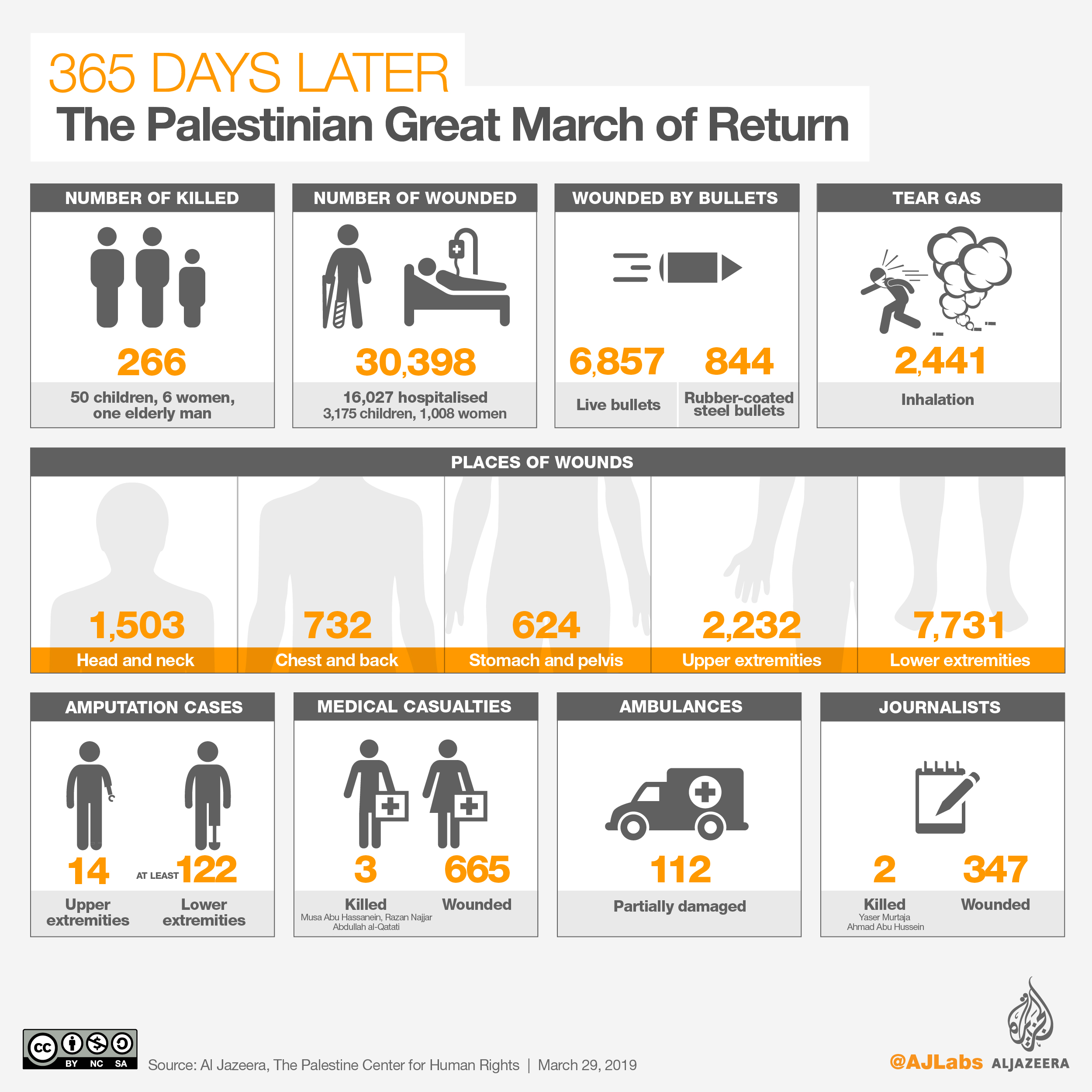Findings
93. The commission investigated all 189 fatalities and tracked more than 300 injuries caused by the Israeli security forces at the demonstration sites and during the demonstrations.
94. With the exception of one incident in North Gaza on 14 May that may have amounted to “direct participation in hostilities” and one incident in Central Gaza on 12 October that may have constituted an “imminent threat to life or serious injury” to the Israeli security forces, the commission found reasonable grounds to believe that, in all other cases, the use of live ammunition by Israeli security forces against demonstrators was unlawful.
95. Victims who were hundreds of metres away from the Israeli forces and visibly engaged in civilian activities were shot, as shown by eyewitness accounts, video footage and medical records. Journalists and medical personnel who were clearly marked as such were shot, as were children, women and persons with disabilities.
96. The Israeli security forces killed and maimed Palestinian demonstrators who did not pose an imminent threat of death or serious injury to others when they were shot, nor were they directly participating in hostilities. Less lethal alternatives remained available and substantial defences were in place, rendering the use of lethal force neither necessary nor proportionate, and therefore impermissible.
97. The commission therefore found reasonable grounds to believe that demonstrators were shot in violation of their right to life10 or of the principle of distinction under international humanitarian law.
98. The commission found that at least 29 of those killed at the demonstration sites were members of Palestinian organized armed groups. It is aware that the international legal community holds divergent views on whether organized armed group members may be targeted at any time, or only when directly participating in hostilities. In accordance with the law enforcement paradigm as informed by international human rights law and in the absence of arms and active hostilities, the commission concluded that, in this specific context, targeting individuals purely on the basis of their membership of an armed group and not on their conduct at the time was impermissible. The applicable tests remain whether an individual, at the time targeted, was directly participating in hostilities or posed an imminent threat to life. If not, targeting of such persons with lethal force was unlawful.
99. The shooting by Israeli security forces of Palestinian demonstrators with high-velocity weaponry at close range resulted in killings and long-term, life-changing injuries, including paralysis and amputations. Although this was well known as early as April 2018, Israeli forces continued this practice throughout the period under review. Using such weaponry at short range, and justifying it by the need for accuracy at long range, indicates a disproportionate use of force.
100. The right to life includes the right to a life with dignity. As the occupying Power, Israel has obligations under international law to ensure the health and welfare of the Palestinian population. The commission found that the ongoing blockade of Gaza and its impact on the health-care system in Gaza, and the ensuing deprivation of essential goods and services necessary for a dignified life, including basic medical supplies, safe drinking water, electricity and sanitation, constitute violations of the fundamental rights to life and health, in particular of wounded demonstrators.
101. International human rights law protects demonstrations under the freedoms of expression, of peaceful assembly and of association. While not all demonstrators were peaceful, the commission found reasonable grounds to believe that the excessive use of force by Israeli security forces violated the rights of the thousands who were.
18
10 International Covenant on Civil and Political Rights, art. 6.
102. The Convention on the Rights of the Child protects children’s rights to life, peaceful assembly, expression and the highest attainable standard of health, among other rights. The commission found reasonable grounds to believe that Israel violated those rights when its forces used lethal force against children who did not pose an imminent threat of death or serious injury to others at the time they were shot.
103. Customary and conventional international humanitarian law requires that medical personnel be respected and protected. Similar protection is afforded to journalists and children who do not take part in hostilities. The commission found that the Israeli security forces shot paramedics, journalists and children who had not lost their protected status; Israel is thus in violation of international humanitarian law.
104. Some members of the higher national committee, including Hamas, encouraged or defended demonstrators’ use of incendiary kites and balloons, causing fear and significant damage in southern Israel. The de facto authorities in Gaza failed in their due diligence obligations to prevent and stop the use of these indiscriminate devices.
105. The commission found that, on 14 May, at least one gunman fired a weapon at the Israeli forces from within or near the demonstrations at a temporary demonstration site in North Gaza. Firing from the vicinity of a crowd of unarmed demonstrators endangers civilian lives and risks violating the principle of distinction under international humanitarian law.








